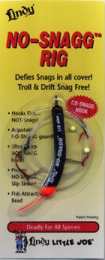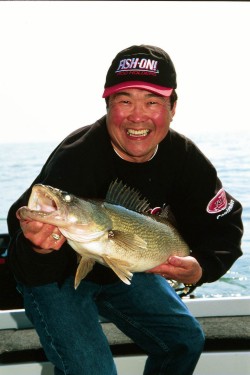












Promotional
Team Favorites
Lodging food and more








|
Get in the Game
By Ted Takasaki and Scott Richardson
Everyone can use a game plan to catch more walleyes. The one used by
Jason Przekurat, the 2003 RCL Angler of the Year, is easy to remember
and effective when put into practice. It goes this way..North to South,
Inside and Out.
Northern areas of lakes and reservoirs tend to warm first, especially
if
that's where the feeder river and creeks empty in. After spawn, fish
move south along shoreline structure. As water warms, they migrate
from
the shoreline to deeper parts of the body of water.
That keeps walleyes on the move. Przekurat has dropped an Aqua-Vu
underwater camera and seen a hundred walleyes only to return to the same
structure two weeks later to see none at all. He commonly catches walleyes
on Green Bay in his home state of Wisconsin that the Michigan Department
of Natural Resources tagged only a short time earlier many miles away.
"Walleyes are simple to catch, but very hard to find," Przekurat said.
"They're here one day and gone the next. They're nomads. ...If you can
find them, you can usually catch them."
Putting fish in the boat is a matter of the right location, the right
presentation and enough confidence to know you can do it.So how do you
track them down?
"A lot of guys are shocked when they pull onto a ramp and ask where
do
we start?"So, repeat after us - north, south, inside and out. Finding
fish begins when you buy a map of your targeted lake. Don't wait until
the last minute. Give yourself enough time to study it and learn all you
can.
The first step -- and the one often overlooked -- is to read the map
legend. That's the box that tells you how to translate all the map's abbreviations.
You need to know what a stump field, standing timber or weed bed looks
like. You need to know what it means when the contour lines are close together
to signal a sharp drop-off or farther apart, denoting a flat. Good maps
also indicate important transitions from sand, gravel or rock to mud.
Look for the inlets, which bring in warmer water during the spring.
Next, identify the structures that might hold fish at various times of
year. Include the flats used for spawning and to feed, the areas with cover
of all kinds that attract ambush predators like walleyes, the drop-offs
where they may lurk, mid-lake mud flats, humps and others. The next step
is to evaluate the fish-holding potential of each one. Small structures
and those void of cover -- what Przekurat terms as "boring" places -- won't
hold as many walleyes as larger ones that offer a variety of cover to hide
for both walleyes and their prey.
Now you're ready to apply what Przekurat calls the most important factor
in walleye location."Fish location depends upon water temperature,"
he said. "The colder it is, the closer they are to spawning areas, the
warmer, and they'll set up in other places." Surface temperature should
be 45 to 52 degrees at about the time of the walleye opener in May. Forget
the southern section of the lake for now unless there are isolated bays
within the lake. Look for walleyes
spawning on harder bottom flats in the northern sections of lake, which
the sun will warm first. Best locations are near rivers and creeks that
provide warmer water.
Catch walleyes by pitching jigs.Walleyes begin feeding shortly after
they lay their eggs. As water warms from 50 to 60 degrees, begin moving
gradually toward southern structures. Look for major feeding opportunities,
such as flats that feature emerging weeds or sandbars that stretch from
the shore to deep
water. Przekurat finds casting crankbaits can be deadly at this time
of year.
Don't waste time fishing the entire length of a weedline. Instead,
concentrate on the "something different," such as points, inside turns
and places where one type of vegetation meets another. Those spots signal
a change in bottom content, and that means a wider variety of forage is
present.
As water moves to the 55 to 65 degree range, it's a good time to check
flooded timber. Fish the timber that's related to structure. Pay attention
to what may appear to be minor details. At Devil's Lake, N.D., Pzrekurat
said he found the best standing timber located on steeper breaks close
to shore with rock.

Lindy Little Joe
No
Snagg Rig |
Use slip-bobber rigs, NO-SNAGG jigs tipped with leeches or crawlers.
Cast them into pockets in the wood. Set the hook as soon as the float disappears.
Water warms into the 65 to 70 degree range by mid summer. Walleyes stop
biting, right? Wrong. In fact, they bite more aggressively. A walleye's
preferred temperature range is actually 67 to 71 degrees. You need only
move away from shore to find them. Remember the game plan. In, then out
means you move from the shoreline toward the middle of the lake. Search
for the deeper rock piles that top out in shallow water less than 10 feet
deep."These are generally big-fish magnets," Przeruat said.Start by motoring
around the rock pile in order to identify subtle changes in shape. Anchor
and fish the points and inside turns with slip bobbers, small jigs and
leeches.
|
 |
Mayflies hatch when summer progresses and the water reaches 75 to 80
degrees. This will draws fish to the mud flats. If your state allows trolling,
try it. If not, drift with spinner rigs and nightcrawlers.
Pzrekurat matches the blade size to the average size of the walleyes
in
the lake. For example, try #5's to #8's for the Great Lakes, #3's and
#4's for flowages.A GPS is critical at this stage. Catch a fish, mark
the spot with a way point. Move off to the side and make another pass.
Catch another fish, mark it with another waypoint. Soon, you'll know the
size of the school
and you can troll or drift through it time and again. |
There are always a few variables in the game plan. If you check a
structure that should hold fish at that time of year only to find
unsuitable water clarity, either too dingy or too clear, move on without
wasting time. The suitability of a structure can increase day to day
if
wind is blowing into it.
North, south, in and out - remember the plan and get in the game
|


